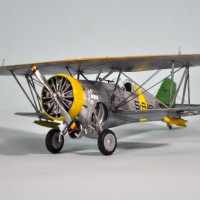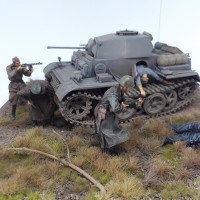Freedom Models 1/48 Hawk III as a BF2C-1
History:
Along with Boeing, the Curtiss Wright Corporation was the most prolific designer and manufacturer of single seat fighter aircraft for both the U.S. Army Air Corps and U.S. Navy between 1925 and 1935.
Curtiss, however, differed fundamentally from both its then competitor, Boeing, and its later competitor, Grumman, in its policy of creating a basic design and improving that incrementally, stretching this over as long a time period as possible to maximize profit with the least investment in development. Admittedly, this was a period in which the technology was such that the same basic design could fulfill the very different requirements of both services, while the rate of change and innovation was relatively slow, thus allowing such a philosophy to find success. Sadly, Curtiss would maintain this policy even as revolutionary changes in aviation technology would begin to appear in the mid-1930s. The result was that after 1945, Curtiss-Wright left the airplane business, while its competitors went on to greater success. Both Boeing and Grumman were interested in advancing the state of the art, and neither had any difficulty abandoning a proven design if some new development held the promise of superior performance.
The Curtiss "Hawk" first appeared in 1925 as the P-1 for the Army Air Corps, and shortly thereafter as the F6C- 1 for the Navy. While the Army used the in-line liquid cooled engine, the Navy opted for the new radial air cooled engine, which was both lighter and more reliable than the current liquid cooled powerplants, an important consideration for an aircraft with wheels flying over large bodies of water. Curtiss was able to turn the radial engined naval fighters that came after this decision into a successful line of export fighters under the "Hawk" designation, selling the aircraft in South America and China, where both the Hawk II and the Hawk III saw a considerable amount of combat in the Chaco War in South America, the Sino-Japanese War and the Thai attack on French Indochina.
By 1935, Grumman had replaced Boeing as Curtiss' chief competitor for Navy contracts, with its FF-1 and F2F-1, and the coming F3F-1, all of which were biplanes with retractable landing gear. In an attempt to compete with these more modern designs, Curtiss modified its F11C-2 as the XF11C-3, with a deepened forward fuselage that allowed for retractable landing gear of the kind used by Grumman; the open cockpit was soon replaced by a heightened turtledeck on the rear fuselage and a half canopy, which was almost always left slid back in the open position. While Curtiss found foreign orders in China and Thailand for the design as the Hawk III, the Navy ordered the aircraft into limited production as the BF2C 1, a new designation that meant the airplane was seen primarily as a dive bomber, with the role of fighter as a secondary requirement.
The BF2C-1s served with VF-5B aboard the USS "Ranger" from October 1936 to November 1937, the shortest operational lifespan of any Naval aircraft of the period. This was due to the fact that in an attempt to modernize a ten year old design, Curtiss had exchanged the traditional wooden wing structure for metal wings. Unfortunately the vibration frequency of this structure was in harmony with the engine at cruising speed. In flight, the airplane seemed to be shaking itself to pieces, no matter the fixes tried by Curtiss and the Navy. Curtiss' final solution was an offer to re-equip the airplanes with the wooden wing of the successful export variant the Hawk III - at the company's expense, but the Navy considered the airplane passé in light of coming designs like the SB2U. The BF2C-1 unceremoniously left service, replaced by the earlier F4B-4 pending re-equipment with more modern monoplanes. Thus, the last Curtiss naval fighter was cast aside, the victim of a failure to keep up with contemporary developments in aircraft design and construction.
The Kit:
Freedom Models is based in the Republic of China (Taiwan) and specializes in producing models of equipment used by the ROC Army and Air Force. The aircraft kits are primarily contemporary jets used by the ROCAF over the past 20 years or so. This Hawk III is their first kit to go back to the ROCAF's early days.
The kit is very well-designed, with a detailed cockpit, engine and retractable landing gear, and excellent surface detail overall. It is dimensionally accurate and also fully accurate in shape. The kit provides decals that will allow a modeler to make any of the Hawk IIIs that engaged in the defense of Shanghai against the Japanese in 1937. While most histories say the Chinese were overmatched and easily dispatched by their opponents, the IJNAF was forced to bring in a squadron of A5M1 and A5M2 fighters because of the success of the ROCAF Hawk IIIs against the G3M1 bombers raiding Shanghai.
The kit also provides decals for the Hawk IIIs used by the Thai Air Force, which are much more colorful in camouflage scheme than their Chinese counterparts. These aircraft saw combat during the brief “incident” between Thailand and French Indochina in 1941.
Construction:
When I picked up this kit back in October from RebelAlpha on eBay, I was torn between doing one of the ROCAF Hawk IIIs or the Thai aircraft, which I had seen in restored condition at the RTAF Museum at Don Muang Airport in Bangkok back during my Navy days. But I was also interested in the BF2C-1, for my interwar NavAir collection. Then another member of this forum did his take on turning the kit into the Navy dive bomber and I concluded that was what I would also do.
It turns out the conversion to the BF2C-1 is not difficult. The hardest part is modifying the cowling from the semi-NACA cowling used by the Hawk III back to the Townend Ring used by the BF2C-1. I ended up cutting off the forward section of the cowling after carefully scribing a straight cutting line around both parts, reducing the chord by about 1/16 inch. I then cleaned out the front area of the cowling and - voila! - I had the needed Townend Ring. The prop was modified from a three-bladed prop to a two-bladed prop, which was not hard at all.
After doing that, I followed the very detailed and excellent instructions in constructing the model. The cockpit parts were painted with Tamiya Flat Aluminum before assembly, and I used a set of Eduard photoetch US Navy pre-war seatbelst. I assembled the full engine before painting, airbrushing it with Flat Aluminum and then brush painting various bits of it in various shades of Vallejo metal colors.
I left the engine and cowling off until after painting, as well as the vertical fin and rudder, and the horizontal stabilizers. I attached the lower wings, the cabane struts and the landing gear before painting.
Colors and Markings:
The upper surface of the wing was painted US Navy “Chrome Yellow,” done by mixing Tamiya “Lemon Yellow” and “Orange” to get the orange-tinted shade of the Navy color. The tail surfaces were painted Willow Green, from a mixture of Tamiya X-28 “Park Green,” X-15 “Light Green” and X-8 “Lemon Yellow” to get the bright yellow-tinged shade that is USN “Willow Green.” The cowling was painted with “Lemon Yellow” to match the decal markings I was going to use.
The fabric surfaces of the underside of the upper wing, the fuselage and the lower wings, were painted with Vallejo “White Aluminum” after painting those areas with Tamiya X-18 “Semi-gloss Black” as a primer. After that dried fully, I gave those areas a coat of Clear Satin. When that was dry, I masked those areas using super low-tack drafting tape and then I used Vallejo “Aluminum” for the metal areas of the fuselage and the interplane struts.
I used the Yellow Wings Decals sheet 48-058 for the F-11C-2/BFC-2 Goshawk, using the option for the sixth section leader. I got the side numbers and the mounted knight squadron insignia from Yellow wings 48-008 SB2U-2 Vindicator; the knight actually as “2" on his shield for VB-2, which was previously VB-5, but in 1/48 that is small enough you can't really notice. I pieced together the “BF2C-1" designator from the BFC-2 sheet, and got the serial number from an old Accurate Miniatures F3F sheet full of proper-size numbers.
I attached the upper wing to the cabane struts using CA glue, then attached the interwing N struts and the aileron-actuator strut. I used the kit-supplied photo-etch rigging (a nice idea other manufacturers could copy for biplane kits) and finally attached the engine, cowling and prop, as well as the main wheels and the half-canopy, which I posed open.
U.S. Navy airplanes of this period were kept in spotless condition, so I did no weathering to the model.
Conclusions:
This is a really nice, accurate kit that makes up into a good looking model. Done OOB, it results in a nice model of an historically-significant fighter and a good addition to your Pacific War collection. Converting it to a BF2C-1 is not difficult. If you have any experience with Eduard World War I kits, you'll have no trouble with this kit.















Beautiful looking aircraft Tom. There's only two things that prevent me from doing biplanes: wings and things between wings
I built my first one (the old Hawk Nieuport 17, still available from Testors before they went out of business) when I was around 10, too ignorant to know it was "hard." 🙂
That’s sharp Tom.
Really well done Tom.
Nice work Tom. I've got one of these and to me the rib effect on the wings is very over done and the rear fuselage is also not good. Sanding down on these surfaces will greatly improve the overall look of the model.
Not overdone at all when you look at photos.
Looks good Tom. I'm just venturing into the Vallejo Metal Colors, and I'm liking them very much! some of your earlier articles encouraged me to give them a go.
Nicely done!
most attractive...green bay packer...wonder if flatly had anything to do with it (smile)
Really well done, Tom. I may have to revisit the cowling on mine as I overlooked that detail. The orange yellow upper wing is such an appealing color to me!
Robert - it's not hard to do, just be sure to draw a "cut line" on it.
Thanks for doing yours, which decided me on what I was going to do with mine.
Beautiful little plane with its bright colors !